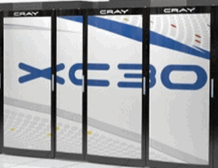While large scale supercomputing centers continue to push the boundaries of the ability to process numerical information, either HPC like or Big Data like, a concern is the ability for the datacenter to power and cool such large installations. The new Cray XC Supercomputer is an energy efficient advancement to the traditional cluster. In this whitepaper, Cray discusses:
- Integration into state-of-the-art datacenters
- Transverse cooling system innovations
- Efficient power distribution
- Control and monitoring of power consumption
- Cray Inc. energy-efficiency initiatives
The Cray XC40 system is a distributed memory system that addresses the most demanding end user requirements in an energy efficient manner. Rather than just cobble together industry standard servers, Cray has engineered a design which gives users the computing power they need, while reducing power consumption. A novel idea is the term, “Energy to solution” which is metric that is composed of the “time to solution” X “power consumption” X PUE .
 While traditional datacenter designs include chillers, CRAC units and coolant distribution units, this reduces efficiency of the overall cooling systems with so many components. Using alternative techniques such as free cooling with warm water, eliminates much of these inefficiencies. The water which is used to take away heat from the servers and other hardware in the datacenter is actually cooled by external air. Using this technique will of course depend on the outdoor climate. Since the Cray XC40 systems can use warmer inlet temperatures than previous systems, more of these designs using external temperatures could be implemented.
While traditional datacenter designs include chillers, CRAC units and coolant distribution units, this reduces efficiency of the overall cooling systems with so many components. Using alternative techniques such as free cooling with warm water, eliminates much of these inefficiencies. The water which is used to take away heat from the servers and other hardware in the datacenter is actually cooled by external air. Using this technique will of course depend on the outdoor climate. Since the Cray XC40 systems can use warmer inlet temperatures than previous systems, more of these designs using external temperatures could be implemented.
The Cray XC40 system is designed to scale beyond 92,000 nodes. This allows for massive computational power to be uses, while allowing end users to mix and match compute and I/O capabilities depending on their workflow requirements. As energy efficient computing has become a critical discussion due to the cost of electricity, the Cray XC40 cooling system has been designed to reduce the amount of power needed. By using transverse cooling, where the airflow cools the components side to side, with cooling cabinets placed between the racks, more efficient cooling is the result. The solution can scale quite high, and reduces the need for hot and cold aisles.
The Cray XC40 cooling system is a significant step forward in reducing the infrastructure and complexity of cooling large number of blades and computing power. To get a detailed understanding of the cooling innovations of the CRAY XC30 and XC40 systems along with the power requirements, download the whitepaper, The Cray® XC™ Supercomputer Series: Energy-Efficient Computing.
Download this very informative and technically written whitepaper now.




